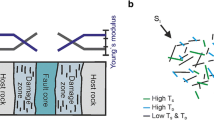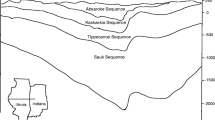The existence of faults in deep carbonate reservoirs is characterized by the complex stress field near faults, which has a great influence on the extension of induced fractures and the formation of the fracture network. In this paper a numerical procedure is proposed for the regional boundary stress determination. Fault zone properties were defined by measurement of the samples and were further verified by comparing the calculated stress values with the measured values for the fault zone. The change in the principal stress value and orientation and the perturbation area were quantified. The authors analyzed the boundaries of the areas at the ends of the fault where the horizontal principal stress difference increases and decreases symmetrically. The influence range increases with the increase in the fault length. The stress concentration determined by the fault structure increases or decreases markedly in the area near the fault tip.




Similar content being viewed by others
References
Y. Wu, J. S. Dai, Y. C. Gu, et al., "Numerical simulation of present geo-stress field and its effect on hydraulic fracturing of Fuyu reservoir in Gaotaizi oilfield, " J. Geomech., No.4, 363-371(2014).
S. Z. Shi, Y. H. Yu, Z. L. Sun, et al., "The in-situ stress characteristics and fracture extension direction on Lower Raramay formation of Qidong-1 area in Xinjiang oilfield," Sci. TechnoL Eng.,15(17), 117-120 (2015).
J. Rutqvist, A. P. Rinaldi, F. Cappa, et al.. "Modeling of fault reactivation and induced seismicity during hydraulic fracturing of shale-gas reservoirs," J. Pet. Sci. Eng., 107(4), 31-44 (2013).
J. Rutqvist, A. P. Rinaldi, F. Cappa, et al., "Modeling of fault activation and seismicity by injection directly into a fault zone associated with hydraulic fracturing of shale-gas reservoirs," J. Pet. Set Eng., 127, 377-386 (2015).
X. Qin, Q. Chen, M. Wu, et al., "In-situ stress measurements along the Beichuan-Yingxiu fault after the Wenchuan earthquake," Eng. Geol., 194, 114-122 (2015).
H. A. Rhair, D. Cooke, and M. Hand, "Paleo stress contribution to fault and natural fracture distribution in the Cooper Basin," J. Struct. Geol., 79, 31-41(2015).
M. J. Nasehi and A. Mortazavi, "Effects of in-situ stress regime and intact rock strength parameters on the hydraulic fracturing,"J. Pet. Set Engin., 108(4), 211-221 (2013).
S. Zhang and S. Ym, "Determination of in situ stresses and elastic parameters from hydraulic fracturing tests by geomechanics modeling and soft computing," J. Pet. Sci. Eng., 124, 484-492 (2014).
W. Cheng, Y. Jin, and M. Chen, "Reactivation mechanism of natural fractures by hydraulic fracturing in naturally fractured shale reservoirs," J. Nat. Gas Set Eng., 23, 431-439 (2015).
P. L. P. Wasantha and H. Konietzky, " Fault reactivation and reservoir modification during hydraulic stimulation of naturally-fractured reservoirs," J. Nat. Gas Set Eng., 34, 908-916 (2016).
Acknowledgements
This study was supported by National Natural Science Foundation of China (Grant No. 51674044), National Science and Technology Major Project (No. 2017105005-005-004), and Project of the Ministry of Science and Technology of Sinopec (P17004-2). Also, we would like to thank Sinopec Northwest Company for providing the measurement data and geotechnical parameters.
Author information
Authors and Affiliations
Corresponding author
Additional information
Translated from Khimiyai Teichnologiya Topliv i Masel, No. 5, pp. 70— 74, September — October, 2019.
Rights and permissions
About this article
Cite this article
Wang, Y., Zhou, J., Geng, Y. et al. Effect of Fault on in-Situ Stress Perturbation in Deep Carbonate Reservoir. Chem Technol Fuels Oils 55, 615–622 (2019). https://doi.org/10.1007/s10553-019-01074-w
Published:
Issue Date:
DOI: https://doi.org/10.1007/s10553-019-01074-w




